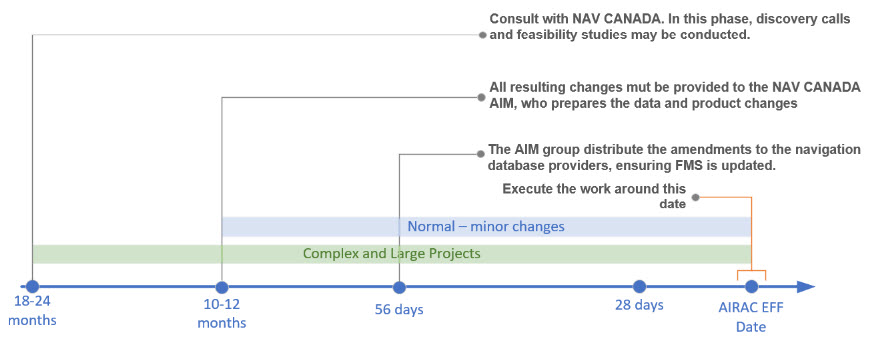







To ensure the integrity of aeronautical information and data (AI/D) is maintained from origination to distribution, NAV CANADA is formalizing the provision of AI/D. Corrupt, erroneous, late or missing aeronautical information and data can lead to potential safety risks.
The following mechanisms are part of the global transition to more dynamic, integrated, immediate and accessible data-centred Aeronautical Information Management (AIM):
To access the weekly AIRAC Canada contact service@navcanada.caOpen a new window.
Your role as an originator of changes to aeronautical information and data: Every effort should be made to provide permanent changes with ample lead time for the changes to be implemented in accordance with the AIRAC system. Every effort should be made to avoid using NOTAM as a fall back for changes other than temporary and of short duration. Remember that an FMS may not contain critical data established by NOTAM. To meet AIRAC requirements planning and collaboration between all parties is necessary and as a result, operations will be smoother.
Important: Before these changes are submitted, discovery discussions and feasibility studies may be required. Large airspace projects associated with significant airport upgrades will require more lead time, that is, 18 to 24 months. In some cases, it could be more. Contact the Customer Relation Coordination group through service@navcanada.caOpen a new window as soon as possible, even if the project approval is pending. The more advance notice the better.
What is AIRAC?
It is essential, for both efficiency and safety, that pilots, dispatchers, air traffic services, air traffic flow managers, flight management systems (FMS) and aeronautical charts all have the same information working from the same information base. As this aeronautical information is constantly changing, and is shared between stakeholders worldwide, it is essential to adopt a universal system that all can follow.
This system is Aeronautical Information Regulation and Control - AIRAC. It is a system consisting of a set of rules and a common schedule for any data that is loaded into an FMS or published in aeronautical information products such as a chart. It is not desirable to implement a significant change on another date since the loading of the FMS and production of charts are done in accordance with a strict and tight schedule. This schedule is applied worldwide.
The advance notification to the navigation data base providers and data integrators allows these organizations to prepare and encode the data to load FMS. Failure by the originators of data changes to adhere to these rules and schedule may result in information not being loaded in an FMS, which cannot be updated manually based on a NOTAM. Therefore, submitting critical information too late can mean that an instrument flight procedure cannot be flown.
AIRAC Procedures

Minor changes such as painting runway designators or redesignation of a taxiway should be physically done near the AIRAC effective date. It is understood that large projects require physical changes to start months prior the effective date.
Direct all aeronautical data submissions and questions to NAV CANADA AIM Data Collection.
NOTAM Entry System (NES)
Reporting authorities can upload Aircraft Movement Surface Condition Reports (AMSCR) directly to the NAV CANADA system using the NES web applicationOpen a new window.
This information is immediately available to customers on the Collaborative Flight Planning System (CFPS) and Aeronautical Fixed Telecommunications Network (AFTN) as an RSC NOTAM. Authorities with an automated reporting system can benefit from the direct web service that links their system directly with the NAV CANADA system.
AMSCR Materials
PDF AMSCR forms have been updated as of August 12, 2021 to reflect the new Runway Surface Condition (RSC) NOTAM format. These forms are now managed and provided by Transport Canada. For access to the new forms, please contact Transport Canada: TC.FlightStandards-Normesvol.TC@tc.gc.ca.
Aerodromes may access the services of contractors to conduct specific work related to instrument flight procedures. NAV CANADA collectively refers to instrument design contractors as External Design Organizations (EDOs). EDOs register with NAV CANADA and have submission requirements allowing NAV CANADA to review and publish their submitted designs to ensure accuracy and compliance to regulations and instrument procedure design criteria.
Instrument Procedure Design Submission Overview for AerodromesOpen a new window provides an overview for aerodromes of the process and requirements for submission of instrument procedures to NAV CANADA for review and publishing.
Important forms include: